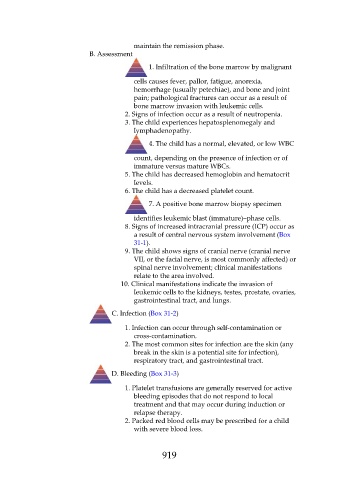Page 919 - Saunders Comprehensive Review For NCLEX-RN
P. 919
maintain the remission phase.
B. Assessment
1. Infiltration of the bone marrow by malignant
cells causes fever, pallor, fatigue, anorexia,
hemorrhage (usually petechiae), and bone and joint
pain; pathological fractures can occur as a result of
bone marrow invasion with leukemic cells.
2. Signs of infection occur as a result of neutropenia.
3. The child experiences hepatosplenomegaly and
lymphadenopathy.
4. The child has a normal, elevated, or low WBC
count, depending on the presence of infection or of
immature versus mature WBCs.
5. The child has decreased hemoglobin and hematocrit
levels.
6. The child has a decreased platelet count.
7. A positive bone marrow biopsy specimen
identifies leukemic blast (immature)–phase cells.
8. Signs of increased intracranial pressure (ICP) occur as
a result of central nervous system involvement (Box
31-1).
9. The child shows signs of cranial nerve (cranial nerve
VII, or the facial nerve, is most commonly affected) or
spinal nerve involvement; clinical manifestations
relate to the area involved.
10. Clinical manifestations indicate the invasion of
leukemic cells to the kidneys, testes, prostate, ovaries,
gastrointestinal tract, and lungs.
C. Infection (Box 31-2)
1. Infection can occur through self-contamination or
cross-contamination.
2. The most common sites for infection are the skin (any
break in the skin is a potential site for infection),
respiratory tract, and gastrointestinal tract.
D. Bleeding (Box 31-3)
1. Platelet transfusions are generally reserved for active
bleeding episodes that do not respond to local
treatment and that may occur during induction or
relapse therapy.
2. Packed red blood cells may be prescribed for a child
with severe blood loss.
919

